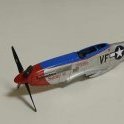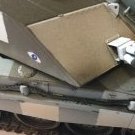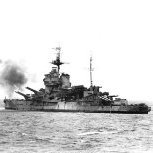-
Posts
5,787 -
Joined
-
Last visited
-
Days Won
8
Jamie @ Sovereign Hobbies last won the day on July 29 2023
Jamie @ Sovereign Hobbies had the most liked content!
About Jamie @ Sovereign Hobbies

Contact Methods
-
Website URL
http://www.sovereignhobbies.co.uk
Profile Information
-
Gender
Male
-
Location
Aberdeenshire, UK
-
Interests
Constructive feedback on my modelling is welcome
Recent Profile Visitors
17,964 profile views
Jamie @ Sovereign Hobbies's Achievements

Completely Obsessed Member (6/9)
16.9k
Reputation
-

Royal Navy Submarines in the Far East
Jamie @ Sovereign Hobbies replied to DFritz's topic in Maritime WWII
Hi, I am unaware of any official record of such a paint, and have the impression that the submarine fleet generally didn't feel particularly constrained by official guidance half a world away through much of the war. In an official letter I do have dated to 1939 reporting on what colours were in use by the fleet on foreign stations, cruisers and larger vessels are described as being light grey overall, destroyers as having dark grey hulls and light grey upperworks, and submarines being "royal blue" on Mediterranean Station and "dark olive colour" on China Station. From there until P.B.10 is introduced in 1944 there's a gap in the records I have seen, save for some documentation on anti-fouling paints.- 1 reply
-
- 2
-

-
That's fine. I think there's a period of adjustment for many people though, as they expect to see red and anything else doesn't feel right until they get used to the idea. The number of grey ships increases though Geun Sup Yoon's HMS Formidable, for example, looks really attractive with grey anti-fouling I think http://www.modelshipgallery.com/gallery/cv/hms/Formidable-700-gy/images/fmd02.jpg
-
Hi Jeff, she never had red. She used Peacock & Buchan's products her entire career, who only ever supplied anti-fouling in black or grey shades. Of the years where the colour is positively documented, it was grey.
-

HMS Wellington Camouflage Colours
Jamie @ Sovereign Hobbies replied to mindenroses's topic in Maritime WWII
If we're talking about April 1942, we can definitively rule out any notion of B15 which whilst similar in appearance to B5 is later nomenclature which didn't exist at the time. Similarly, MS4a was joint lightest of all the RN camouflage paints with Western Approaches Light Blue, and lighter only than white. Indeed in many black and white images it's quite difficult to tell MS4a from white. Here our ship wears a white Pendant number and white draught markings clearly contrasted against the lightest camouflage paint. I think the obvious contrast of white markings on this lightest camouflage paint rules out any possibility of it being MS4a. To demonstrate the point, here is an example of what we believe to be MS4a on HMS Victorious' starboard quarter. The draught markings are nominally white, but where the MS4a panel encroaches over the draught numbers someone has had to paint those black. The camouflage on HMS Wellington is in the distinctive style of a Western Approaches design, although the colours themselves do not appear to be Western Approaches, instead appearing much darker. This feels more like MS2 and MS4 or 507A and MS4 to me, but we'd want a larger sample size of images as lighting conditions can give very different impressions. Still, I'm confident we're not looking at MS4a. -

1/48 F-86A: it's almost here...
Jamie @ Sovereign Hobbies replied to Sabrejet's topic in The Rumourmonger
Nice! -

HMS Rupert Captain Class Frigate 1/350
Jamie @ Sovereign Hobbies replied to neilh's topic in Work in Progress - Maritime
Likewise please accept my condolences Neil. -
May I suggest using our HMS Howe profile instead as a starting point? From mid 1943 this would have been altered slightly as follows: MS1 replaced by G5 - no visual difference B5 replaced by B15 - no visual difference MS4 replaced by B30 - slightly greenish grey replaced by blue-grey of same brightness 507C replaced by G45 - no visual difference https://cdn.shopify.com/s/files/1/0730/0927/files/HMS_Howe.pdf?v=1609588685 Unfortunately the KGV class disruptive scheme is often poorly portrayed in many sources including all currently available printed books.
-
I'm not sure I have a clear aerial photograph showing the entirety of this deck area in this time period, but I have one photograph in this fit which shows the forward part of it clearly whilst there are awnings rigged towards midships obscuring the rest. What can be seen is all Corticene including under the forward most single QF mounts. Were this model mine, I'd paint the whole area to represent Corticene linoleum matting. The Semtex areas I've shown on the illustration available on the H.M.S. Hood Association website as well as my own would not have been Semtex specifically as it didn't exist in 1931. If there was something else under the single QF mounts, I think it would be fairly consistent under all the QF mounts and as I say the forward QF mounts just have continuous Corticene.
-
Yes the above is a good example of the diplomacy being exercised... For the record I don't think Mountbatten was completely stupid, he just didn't have any data or understanding of the reasons for his perceptions. He was probably correct in his letter that 507A was perhaps too conspicuous, and his Mountbatten Pink would in certain conditions be less conspicuous. The reason it was less conspicuous though wasn't because it was pink but because it was lighter.
-
Indeed that's where the inspiration is credited to have come from. The effectiveness of Mountbatten Pink was objectively tested though and proved no different to ordinary grey paint of the same Light Reflectance Value in its most effective conditions but somewhat more conspicuous at its worst. The camouflage experts trod quite carefully in drafting documents steering Ships towards more effective camouflage measures whilst avoiding the possibility of insulting Mountbatten by denouncing his pink paint as the total nonsense it was.
-
Mountbatten Pink is a weird colour. It was made using pigment oil pastes already available through the stores and logistics system; specifically those used for Home Fleet Grey albeit with a reduced quantity of the ultramarine & black Pattern 370A blue-black paste and Venetian Red added instead. It's a bit too "odd" to have any shared characteristics with other armed forces colours served by the model paints marketed, whilst being too dull and drab to have much civilian appeal or application. All that said, I did discuss HMS Campbeltown with @dickrd some time ago and the origins of the first reference to Mountbatten Pink of the ship (or even the fleet!) are not that clear. It's not from a known primary source reference and the challenge with secondary source references i.e. books is establishing who exactly said something to the author. I don't think that has been established. The upshot is that whilst it's difficult to categorically rule out Mountbatten Pink (i.e. I'm not saying it's wrong) it's also difficult to rule out grey. Indeed with the modifications undertaken structurally to make the ship somewhat resemble a German destroyer at a distance, one may speculate that painting it pink might somewhat undermine the disguise.
-
Hi EJ, I had not infact seen that particular clip before although it's somewhat ghostly seeing Orkney in colour on cinefilm as I recognize some of those locations and the place looks much the same today unlike Shetland where I was born which underwent a drastic "modernisation" at the end of the 1970s and 1980s with the establishment of the UK's oil industry which passed Orkney by. Fortunately the clip of Nelson doesn't change my views of what colours she was wearing. I think we can safely say this was still fairly early in the stated time window too thanks to particular details in the camouflage design which were painted out in 1943.
-
Jadlam might want to double check they're not committing an offence with how they're posting Class III Flammable Liquids. A private individual may get a degree of leniency citing ignorance, but ignorance will be no defence in court for the Directors of a commercial business. https://www.gov.uk/shipping-dangerous-goods/rules-for-different-types-of-transport By air You can be given an unlimited fine, sentenced to 2 years in prison or both if your cargo fails an inspection or causes a safety incident. By road There’s a range of fixed penalty fines if your cargo fails a spot check. By sea You can be fined for breaking the regulations on transporting dangerous goods. You can be prosecuted and face a large fine and a prison sentence for serious breaches, for example transporting animal by-products in an unsafe way.
-

Am I insane for even thinking about this?
Jamie @ Sovereign Hobbies replied to Notty's topic in Diorama Chat
I think a better option to explore (as well as being a lot cheaper and lighter) would be to just mount it in an acrylic case. If you're not too ambitious with the sea state then cutting a U-Boat shape out of an acrylic sheet to fit around the boat supporting it vertically, you can then do all the acrylic medium stuff on top of it and hide any longitudinal joint quite effectively as well as fill in any imperfections where it meets the hull will all work quite well. To avoid complete transparency, you can tint the acrylic sides of what's effectively a fish tank with translucent bluish green. The beauty of this is that you can build it up slowly and try your boat in to see what visual effect you get. Just like an actual fish tank with water in it, you'll find that a solid resin casting isn't actually all that good for viewing the model inside - it's fine absolutely square on to the side of the piece but look at an angle and refraction does all sorts of weird things so you can't really admire your model as much as perhaps envisaged.- 16 replies
-
- 2
-
















